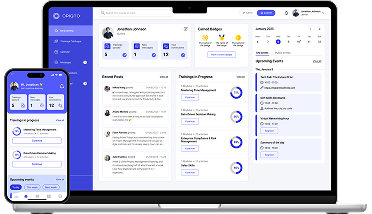If 2020 has taught us anything, it’s that no one can predict the future.
As a business owner you can forecast sales, watch market trends, and listen to industry experts. But in the end, the one thing you can count on is for business to be in a state of continuous change. To thrive, you need to invest in developing the biggest source of innovation and flexibility your organization has available: your people.
The new world of work is about skills, not necessarily degrees
Jamie Dimon, Chairman and CEO, JPMorgan Chase & Co
Preparing your workforce to handle continuous change is critical when it comes to future-proofing your organization. That means:
- Upskilling employees as new technologies change the skills they need to do their jobs.
- Devising a training program that develops existing talent as part of your internal hiring pipeline, rather than relying on the tight jobs market
- Empowering your team to learn what they need, when they need it, so they can handle every challenge that comes their way.
You can do this all with a training program that is skills-focused, flexible enough to meet the needs of every learner, and embedded into your culture.
Focus on the skills
“The new world of work is about skills, not necessarily degrees,” said Jamie Dimon, Chairman and CEO, JPMorgan Chase & Co in a press release from March 2019. The company was announcing a new initiative to identify the skills JPMorgan Chase will need in the future and map that to their internal training program.
Many organizations are still thinking about their talent needs in terms of roles to be filled, and evaluating talent based on degrees, certificates, and prior job experience. The future-proof organization, however, is thinking about skills they’ll need and how to train up those skills in current workers and new hires.
For example, if you’re developing a product training for your sales team, the first module might be a knowledge assessment about your company’s overall product lines. Depending on a user’s performance on that assessment, they may be routed to later modules that dig deeper into specific detail of product lines they’re not as familiar with.
Stay flexible
In training for those skills, your L&D program needs to take into account the diverse learning needs of your organization.
While one employee may prefer a self-guided training, another might learn concepts better from an instructor, or through conversations with a peer. Build training in a way that allows for blended and social learning to help every employee engage.
Once you’ve set things up, the learning path will be automatically adapted for all users.
Learners may also come to a training with different levels of knowledge. To make sure every employee gets the depth of training they need without having to sit through material that isn’t relevant, use adaptive learning pathways to tailor content to each individual.
Also, keep in mind that there is a time and a place for in-depth training, but sometimes an employee may only need a piece of just-in-time information to complete a task. Provide training options that meet both of those goals.
Create a culture of learning
A workforce that’s always learning is one that’s prepared for any challenge the future throws at them. Yet many organizations still view training as something meant for discrete moments: an orientation training for a new hire, a security awareness training for the customer service team, a new product explainer for the sales staff.
Instead, try to create a culture of continual learning, where employees are encouraged to stay curious and improve their own skill sets. This fosters a growth mindset in your employees, and your organization as a whole.
With a flexible, skills-based training program that’s a core part of your organizational values, your company will be as prepared as possible to meet the future, whatever it may bring.
